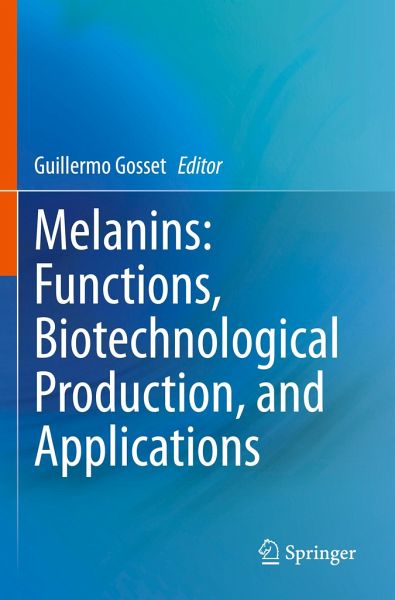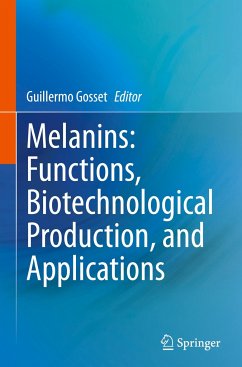
Melanins: Functions, Biotechnological Production, and Applications
Versandkostenfrei!
Versandfertig in 6-10 Tagen
129,99 €
inkl. MwSt.

PAYBACK Punkte
65 °P sammeln!
This book provides an up-to-date overview of the biological functions of melanins, their biotechnological production, and their industrial applications.The melanins form a group of polymeric pigments found in most organisms. These natural products are generated by the oxidation of phenolic and indolic molecules yielding melanins, which include eumelanin, pheomelanin, pyomelanin, and the allomelanins. These pigments have diverse biological functions, including photoprotection, thermoregulation, antioxidation, virulence, and metal ion sequestration. Melanins have physicochemical properties that ...
This book provides an up-to-date overview of the biological functions of melanins, their biotechnological production, and their industrial applications.
The melanins form a group of polymeric pigments found in most organisms. These natural products are generated by the oxidation of phenolic and indolic molecules yielding melanins, which include eumelanin, pheomelanin, pyomelanin, and the allomelanins. These pigments have diverse biological functions, including photoprotection, thermoregulation, antioxidation, virulence, and metal ion sequestration. Melanins have physicochemical properties that have proven useful in the optical, electronic, material, agriculture, cosmetic, pharmaceutical, and medical industries.
The chapters in this book provide an in-depth analysis of the current issues and challenges in this field. Topics covered include the properties, biogenesis, and evolution of melanosomes.
The book also addresses the synthesis and industrial production of melanins by microorganisms. The metabolic pathways for the synthesis of several types of polymeric pigments in microorganisms and their role in pathogenesis are reviewed. The large-scale production and purification of melanins to provide this product for industrial applications is a formidable challenge. Two chapters present and discuss the state-of-the-art used for the generation of microbial melanin-production strains and the processes for the biotechnological synthesis and purification of these pigments.
Melanins are polymers that can interact with metals, a chapter reviews this capacity in the context of technological applications, including electrochemical energy storage and metal recovery. These polymers are materials having favorable characteristics for photonic applications, including UV blocking and broadband absorption. The current advances in the application of these pigments in optically active materials are presented and discussed.
The melanins form a group of polymeric pigments found in most organisms. These natural products are generated by the oxidation of phenolic and indolic molecules yielding melanins, which include eumelanin, pheomelanin, pyomelanin, and the allomelanins. These pigments have diverse biological functions, including photoprotection, thermoregulation, antioxidation, virulence, and metal ion sequestration. Melanins have physicochemical properties that have proven useful in the optical, electronic, material, agriculture, cosmetic, pharmaceutical, and medical industries.
The chapters in this book provide an in-depth analysis of the current issues and challenges in this field. Topics covered include the properties, biogenesis, and evolution of melanosomes.
The book also addresses the synthesis and industrial production of melanins by microorganisms. The metabolic pathways for the synthesis of several types of polymeric pigments in microorganisms and their role in pathogenesis are reviewed. The large-scale production and purification of melanins to provide this product for industrial applications is a formidable challenge. Two chapters present and discuss the state-of-the-art used for the generation of microbial melanin-production strains and the processes for the biotechnological synthesis and purification of these pigments.
Melanins are polymers that can interact with metals, a chapter reviews this capacity in the context of technological applications, including electrochemical energy storage and metal recovery. These polymers are materials having favorable characteristics for photonic applications, including UV blocking and broadband absorption. The current advances in the application of these pigments in optically active materials are presented and discussed.












